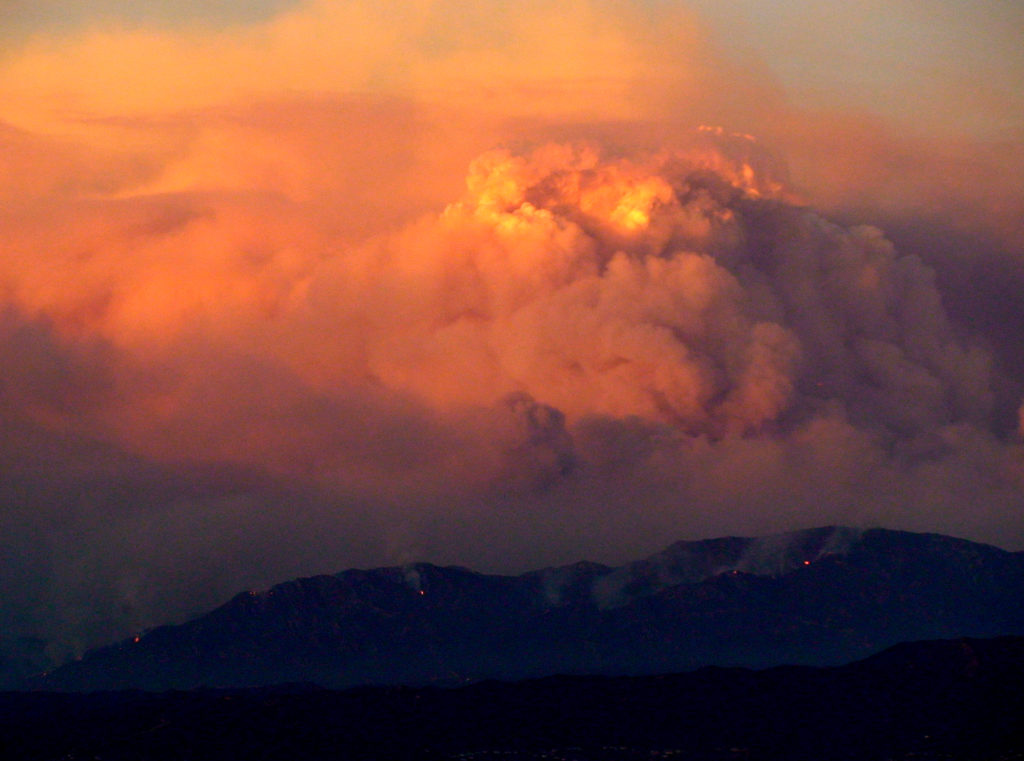Blog · December 11, 2017
Wildfires and climate are related – are Americans connecting the dots?
By Jennifer Marlon and Abigail Cheskis

Photo: “Station Fire” 8/30/2009 looking east from Mulholland Drive, Los Angeles. Credit: Bruce Leiserowitz
California is experiencing a historic wildfire season. Six fires are burning right now — in December — even though only seven December fires have burned in total over the past 17 years. The unusual timing of these fires reflects the rapid lengthening of the fire season in the western U.S., which is now 2.5 months longer than it was in 1970. Large and long-duration forest fires have also increased fourfold.
The western U.S. fire season is longer because spring and fall temperatures are warmer than in the past, due to global warming (on average, annual temperatures in California have increased by about 1.5 degrees Fahrenheit since 1985). When precipitation is plentiful, warmer temperatures promote plant growth. As hot, dry days also increase through summer and fall, this new growth dries out, creating the optimal fuel for fires. In addition, snow is now melting earlier in the spring, which gives plants even more time to dry out. Global warming also alters atmospheric circulation patterns. A study by Miller and Schlegel (2006) predicted that global warming could shift Santa Ana winds from earlier to later in the fire season (and potentially drier and stronger as well) that could significantly increase fires in coastal California, which is consistent with what is happening right now.
Are Americans connecting the dots between global warming and wildfires? Many people in states that experience wildfires currently believe that global warming is making them worse. In California and Colorado, large majorities (69% and 66% of the public respectively) believe that global warming is increasing the severity of wildfires. In Texas, 61% think that global warming is making wildfires more severe.
However, fewer people make this connection in states where wildfires are not common: in Ohio, only 36% of people think wildfires are worse due to global warming. On average, 52% of Americans think global warming is making wildfires worse in the western U.S. These large differences in perception indicate that people often don’t understand global warming’s consequences unless they experience them personally. And even direct experience doesn’t always change people’s minds.
As recent videos of California “commutes through hell” go viral, the media reports about the devastation, and smoke fills the air far beyond the flames, a teachable moment has emerged – an opportunity for many Americans to connect the dots. The media, however, is a critical intermediary. If news sources don’t report and explain the link between wildfires and climate change, it’s likely that those in states less affected by wildfires will not make the connection on their own.
For now, though, it’s vital for those directly affected by the fires to listen closely to authorities and take evacuation messages seriously. Smoke masks are needed to protect the lungs of all people regardless of age and health condition. The New York Times and other news sources have put together fire evacuation guidelines about how to prepare and protect yourself and your home.
For more information on local climate change opinions, see the Yale Climate Opinion Maps.